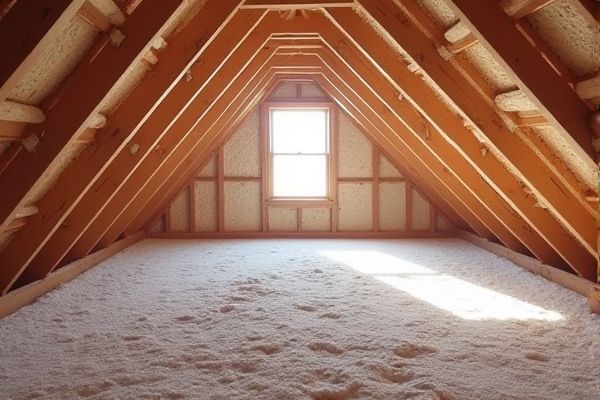
Attic insulation options like fiberglass or cellulose offer cost-effective thermal resistance, while spray foam insulation provides superior air sealing and higher R-values, enhancing energy efficiency and moisture control. Discover which solution best fits your home's needs by exploring our detailed comparison in the rest of this article.
Table of Comparison
| Feature | Attic Insulation | Spray Foam |
|---|---|---|
| Material Type | Fiberglass, cellulose, or mineral wool | Polyurethane foam |
| Installation | Blown-in or batt rolls | Sprayed as liquid, expands to fill gaps |
| R-Value (Thermal Resistance) | 2.2 to 4.3 per inch | 6 to 7 per inch |
| Air Sealing | Limited, requires additional sealing | Excellent, acts as air barrier |
| Moisture Resistance | Absorbs moisture, risk of mold | Resists moisture and prevents leaks |
| Cost | Lower upfront cost | Higher upfront cost |
| Longevity | 20-30 years | 30+ years |
| Environmental Impact | Recyclable materials, but lower efficiency | Potential off-gassing, better energy saving |
| Best Use Case | Budget-friendly insulation upgrade | High-performance thermal and air barrier |
Introduction to Attic Insulation and Spray Foam
Attic insulation commonly uses materials like fiberglass, cellulose, or mineral wool to reduce heat loss and improve energy efficiency by creating a barrier between your living space and the roof. Spray foam insulation, made from polyurethane, expands on application to fill gaps and cracks, providing an airtight seal that enhances thermal performance and minimizes air infiltration. Choosing between attic insulation and spray foam depends on factors like budget, desired energy savings, and the level of moisture control needed in your home.
Types of Attic Insulation
Attic insulation comes in various types such as fiberglass batts, blown-in cellulose, and spray foam, each offering different thermal performance and air sealing capabilities. Spray foam insulation provides superior air sealing and higher R-values compared to traditional fiberglass and cellulose, reducing energy loss and improving indoor comfort. Choosing the right type depends on your attic's structure, budget, and desired energy efficiency.
What is Spray Foam Insulation?
Spray foam insulation is a high-performance material composed of polyurethane that expands upon application, creating an airtight seal in attics and other spaces. Unlike traditional attic insulation such as fiberglass or cellulose, spray foam provides superior thermal resistance (R-value) and effectively prevents air leaks, moisture intrusion, and mold growth. Its ability to conform to irregular surfaces makes it ideal for enhancing energy efficiency and indoor comfort in residential and commercial buildings.
Energy Efficiency: Attic Insulation vs Spray Foam
Spray foam insulation offers superior energy efficiency compared to traditional attic insulation by creating an airtight seal that reduces heat loss and prevents air infiltration. Attic insulation, such as fiberglass or cellulose, provides good thermal resistance but may allow gaps where air can escape, lowering overall efficiency. Your energy bills can significantly decrease with spray foam due to its higher R-value per inch and ability to maintain consistent indoor temperatures.
Cost Comparison: Attic Insulation vs Spray Foam
Attic insulation typically costs between $1 to $3 per square foot, making it a more budget-friendly option compared to spray foam, which ranges from $3 to $7 per square foot due to its higher material and installation costs. While spray foam provides superior air sealing and energy efficiency, the upfront investment is significantly higher than traditional attic insulation materials like fiberglass or cellulose. Your choice will depend on balancing initial expenses with long-term energy savings and comfort improvements.
Installation Process and Requirements
Attic insulation typically involves laying fiberglass batts or blown-in cellulose, which requires proper attic ventilation and protective gear during installation. Spray foam insulation demands professional equipment and expertise due to chemical application and curing processes that create air-sealing benefits. Your choice depends on your comfort with DIY tasks or willingness to hire professionals for faster, more effective air sealing.
Longevity and Maintenance
Spray foam insulation offers superior longevity compared to traditional attic insulation materials, maintaining its R-value and preventing air leaks for over 30 years with minimal degradation. Attic insulation, such as fiberglass or cellulose, typically requires periodic replacement or topping up every 10-15 years due to settling, moisture damage, or pest intrusion. Spray foam reduces maintenance needs by creating an air-tight seal, whereas conventional attic insulation often demands regular inspections and upkeep to sustain performance.
Health and Environmental Impact
Spray foam insulation offers superior air sealing properties, reducing allergens and improving indoor air quality, but it can emit volatile organic compounds (VOCs) during installation, which may affect respiratory health if not properly ventilated. Traditional attic insulation materials like fiberglass and cellulose pose less off-gassing risk but may trap moisture, leading to mold growth and potential health issues over time. Your choice between these options should consider both immediate indoor air quality and long-term environmental impact, with cellulose insulation often favored for its eco-friendly recycled content.
Which is Best for Your Home?
Attic insulation options like fiberglass batts and cellulose provide cost-effective thermal resistance, while spray foam insulation offers superior air sealing and higher R-values per inch, enhancing energy efficiency and moisture control. Homes with irregular attic spaces or significant air leaks benefit most from spray foam due to its ability to create an airtight barrier, reducing heating and cooling costs. Cost and installation complexity play roles; fiberglass is budget-friendly and DIY-friendly, whereas spray foam requires professional installation but delivers long-term energy savings and improved indoor comfort.
Conclusion: Choosing the Right Insulation Solution
Selecting the right attic insulation depends on your specific energy efficiency goals, budget, and climate. Spray foam offers superior air sealing and higher R-values per inch, making it ideal for tight spaces and long-term energy savings. You can optimize comfort and reduce utility costs by evaluating these factors to choose the best insulation solution for your home.
 homyna.com
homyna.com